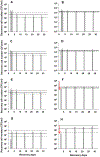Effects of Extended Storage of Chlorhexidine Gluconate and Benzalkonium Chloride Solutions on the Viability of Burkholderia cenocepacia
- PMID: 29032643
- PMCID: PMC12392026
- DOI: 10.4014/jmb.1706.06034
Effects of Extended Storage of Chlorhexidine Gluconate and Benzalkonium Chloride Solutions on the Viability of Burkholderia cenocepacia
Abstract
Chlorhexidine gluconate (CHX) and benzalkonium chloride (BZK) formulations are frequently used as antiseptics in healthcare and consumer products. Burkholderia cepacia complex (BCC) contamination of pharmaceutical products could be due to the use of contaminated water in the manufacturing process, over-diluted antiseptic solutions in the product, and the use of outdated products, which in turn reduces the antimicrobial activity of CHX and BZK. To establish a "safe use" period following opening containers of CHX and BZK, we measured the antimicrobial effects of CHX (2-10 μg/ml) and BZK (10-50 μg/ml) at sublethal concentrations on six strains of Burkholderia cenocepacia using chemical and microbiological assays. CHX (2, 4, and 10 μg/ml) and BZK (10, 20, and 50 μg/ml) stored for 42 days at 23°C showed almost the same concentration and toxicity compared with freshly prepared CHX and BZK on B. cenocepacia strains. When 5 μg/ml CHX and 20 μg/ml BZK were spiked to six B. cenocepacia strains with different inoculum sizes (10⁰ -10⁵ CFU/ml), their toxic effects were not changed for 28 days. B. cenocepacia strains in diluted CHX and BZK were detectable at concentrations up to 10² CFU/ml after incubation for 28 days at 23°C. Although abiotic and biotic changes in the toxicity of both antiseptics were not observed, our results indicate that B. cenocepacia strains could remain viable in CHX and BZK for 28 days, which in turn, indicates the importance of control measures to monitor BCC contamination in pharmaceutical products.
Keywords: Bactericidal effects; Burkholderia cenocepacia; antiseptic; benzalkonium chloride; chlorhexidine gluconate.
Figures





References
-
- Gnanadhas DP, Marathe SA, Chakravortty D. 2013. Biocides – resistance, cross-resistance mechanisms and assessment. Expert Opin. Investig. Drugs 22: 191–206. - PubMed
-
- Gilbert P, Moore LE. 2005. Cationic antiseptics: diversity of action under a common epithet. J. Appl. Microbiol 99: 703–715. - PubMed
-
- D’Arcy PF, Taylor EP. 1962. Quaternary ammonium compounds in medicinal chemistry. I. J. Pharm. Pharmacol 14: 129–146. - PubMed
-
- D’Arcy PF, Taylor EP. 1962. Quaternary ammonium compounds in medicinal chemistry. II. J. Pharm. Pharmacol 14: 193–216. - PubMed
MeSH terms
Substances
Grants and funding
LinkOut - more resources
Full Text Sources
Other Literature Sources

